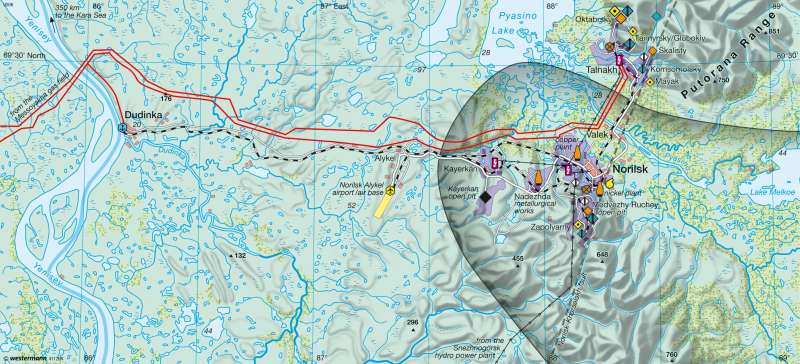Norilsk — Nickel mining under subarctic conditions
Central Asia
978-3-14-100790-9 | Page 85 | Ill. 3

Information
Located on the north-western Central Siberian Plateau, the city of Norilsk owes its existence to the rich deposits of ore in the region. In 1935, the Soviet Council of People's Commissars called for the establishment of an industrial site comprising a nickel mining and metallurgical combine at which ore would be smelted and partially refined. Production began in 1939, and the location was declared an urban settlement that same year. Today, the city of 210,000 situated 300 kilometres north of the Arctic Circle is the northernmost major city in the world. The industrial facilities and the city itself were built with the help of prisoners from the Norilsk Labour Camp. The previously autonomous cities of Talnakh and Kayerkan were annexed and incorporated into Norilsk in 2004.Norilsk has its own airport and is connected by road and rail to the port city of Dudinka, which lies some 70 kilometres to the west and is linked by the Yenisei to the Kara Sea and the Arctic Ocean. The Yenisei channel is kept open by ice-breakers even during the winter months. Ore mined in Norilsk is shipped from the harbour at Dudinka.
The climate in the region is sub-polar. The mean annual temperature in Dudinka is —10.2 °C, and temperatures fluctuate between —28.9 °C und 13.8 °C over the course of the year.
Mining operations
In 1989, the nickel processing combine was reincorporated as the State Concern for Non-Ferrous Metals Production Norilsk Nickel, which has formed the core of the MMC Norilsk Nickel Group since 1993. MMC Norilsk Nickel is one of the largest corporate enterprises in Russia and accounts for 1.5 percent of Russian GDP, according to figures published by the Group. As the global market leader in nickel and palladium mining, the Group produces 21.4 percent of the nickel and 44.8 percent of the palladium traded in the world market (figures for 2008). It is also one of the four largest platinum producers and ranks among the ten leader copper producers in the world. Palladium and platinum are required for the production of catalytic converters in the automotive industry and in weapons manufacturing. The reserves of these metals are sufficient to cover demand for at least 60 years. Cobalt, rhodium, silver, gold, tellurium, iridium, ruthenium and anthracite coal are also mined by MMC Norilsk Nickel.
The international significance of this mining concern is reflected in its overseas expansion. The Group has recently acquired Stillwater Mining, the largest nickel producer in the U.S. It also holds interest in the U.S. hydrogen energy company Plug Power and Goldfields, a precious metals producer in South Africa. The Group is the largest employer in Norilsk, where it provides roughly 80 percent of all jobs. MMC Norilsk Nickel is regarded as the largest single polluter world-wide. The Blacksmith Institute ranked Norilsk as one of the ten most severely polluted cities in the world in 2006. Annual sulphur dioxide emissions alone amount to about two million tonnes. Other pollutants include radioactive strontium 90 and caesium 137, as well as particulate matter, nitrogen oxide, carbon oxides and phenols. The tundra vegetation in the Norilsk area is severely damaged.
H. Kiegel; Ü: J. Southard




